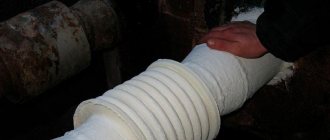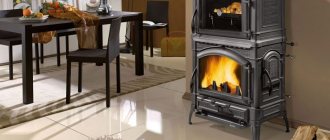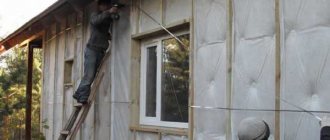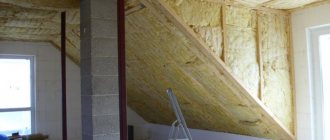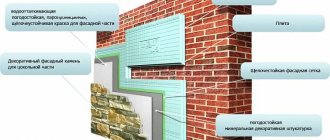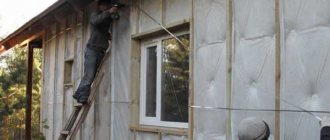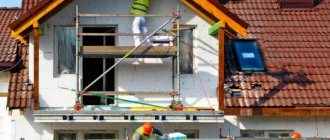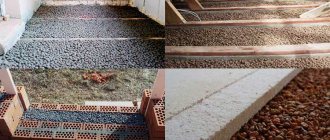Over the past couple of decades, the requirements for building materials regarding their thermal conductivity and insulation abilities have increased significantly. The growing cost of thermal energy, for which you need to pay the market price, forces you to re-arrange thermal insulation even for previously built buildings. We’ll talk about one such technology – heat-insulating plaster (or, more simply, warm plaster) below.
Despite the fact that warm plaster is also used for interior work, it is most often used outside, which imposes a number of restrictions on this material. This information material will be devoted to the composition of the mixture, the nuances of its use, as well as specific brands present on the market.
Insulating plaster – what is it?
Let's look at what warm plaster is. Everyone has long been accustomed to the fact that the classic plaster mixture is a cement-sand mortar containing certain additives. The latter can be lime (to prevent the walls from becoming damp) or all kinds of polymer adhesives (for better adhesion) or even dyes. But what is the mixture for insulating plaster?
In fact, everything is very simple: a filler with a thermal conductivity coefficient significantly lower than that of hardened cement mortar is added to the usual cement-sand mixture (which may also include other polymer components).
Such additives may include:
- expanded vermiculite;
- expanded clay;
- volcanic pumice chips;
- sawdust;
- polystyrene foam granules.
In essence, warm plaster is the same classic plaster mixture that has long been used for finishing buildings and structures, only with additional inexpensive “insulating” components.
Surface preparation.
Important point: If you want to make a plaster layer on top of another insulation, it is first covered with a fiberglass mesh. Then you can apply the mixture as you would on concrete or brick.
Before the solution begins to cover the walls, they need to be prepared. The scheme is standard. First, the surface is cleaned - old wallpaper, paint, and other materials are removed. Then all irregularities are smoothed out. Apply a primer to a dry wall: it should be selected in accordance with the type of plaster used. Then you need to let the primer dry for at least 24 hours. If there are no large depressions, you don’t have to putty. Small irregularities will be hidden by plaster. If the walls are riddled with potholes, it is better to cover them with pre-reinforcing mesh.
Advantages and disadvantages of warm plasters
New properties are added to the familiar material, and since the laying technology has long been proven and is as cheap as possible, the use of such plaster for thermal insulation of buildings provides considerable economic benefits. And this is the first significant advantage of heat-insulating plaster.
The second interesting quality of this material is that such plaster can be used not only as insulation, but also as a humidity normalizer in the room. Some components (for example, sawdust) are able to absorb excess moisture in the air and release it at a reduced concentration of moisture vapor in the atmosphere. And, in addition, warm plaster is an excellent insulator from moisture, protecting capital structures from its effects.
Thirdly, you can easily make a mixture for warm plaster yourself - for this you just need to have the necessary components on hand.
Let us briefly list other useful properties of warm plasters:
- wear resistance;
- environmental safety and cleanliness;
- resistance to temperature changes;
- due to its high adhesive properties, warm plaster can be applied to almost any surface;
- the array forms a single, integral layer, which practically does not require a reinforcing mesh.
However, to be completely objective, it is worth mentioning the disadvantages of thermal insulating plasters. Compared to specialized insulating materials (for example, mineral wool), warm plaster, no matter what it contains as an insulating component, loses by a noticeable margin. To provide the same level of insulation as a stone wool slab, the layer of warm plaster must be twice as thick.
This is why many people call warm plaster a “half solution.” However, if we take into account its economic benefits and technological simplicity, then such a solution may often be quite sufficient.
Types and features
Gypsum heat-insulating plaster has minimal resistance to variable humidity. Therefore, it is used only inside dry rooms. Cement is often used as a base, since it copes with changes in operating conditions much better. For façade elements, exactly these compositions are used.
Plaster with thermal insulation additives for external use differs in fillers, which affect the characteristic properties of the mixture:
- Organic ones are represented by expanded polystyrene with a fraction of 1-1.5 mm, which is not very durable. Added to cement and lime compositions. The versatility of warm plaster is limited by its flammability. It is recommended to treat the coating with materials as a finishing decoration.
- Minerals make up for the deficiencies of organic matter. These include: quartz glass is hydro-resistant, does not allow heat to pass through and does not shrink; porous raw materials of volcanic origin : mica vermiculite is not afraid of anything except water; Obsidian perlite needs protection from moisture.
- Sawdust has a long drying time, but is great for working on brick and wood. Among these fillers are used: sawdust, paper.
The latter mixtures usually have cement or clay as a base. Manufacturers recommend using such mixtures for interior work. This is due to the fact that the presence of wind is not allowed during the drying process.
Mineral fillers also include pumice and expanded clay. These materials are inferior to analogues in all respects, therefore they are used extremely rarely.
Varieties by composition
There are 2 types of heat-insulating plaster mixtures:
- Warm cement plaster. This includes all of the above cement-containing mixtures with the specified additives.
- Foamed plaster. A component is added to the cement-containing mixture that causes the formation of foam when interacting with water. The structure of the solution in this case will be similar to foam concrete in both its raw and hardened form. This type of plaster has significantly higher thermal insulation properties, but it requires mandatory subsequent processing - painting, since the porous structure, like a sponge, can effectively absorb moisture.
We dilute the mixture.
The ready-made store-bought mixture is diluted in approximately the same way. It is important to knead the entire package at once. Therefore, it is worth acquiring a capacity of at least fifty liters. The mixture is poured into water and stirred for about five minutes with a construction mixer. Then another five minutes are given for the solution to “mature”. Detailed instructions for preparing the mixture can be found on its packaging.
Expert advice: you can check the readiness of the solution in this way - scoop up the mixture with a trowel; if the mixture does not slide off it, everything is fine.
The resulting solution must be used within two hours. Then it starts to freeze.
Rating of the best
Let's consider several main brands of mixtures for warm plasters:
UMKA® UB-21 TM
Here, ceramic silicon balls are used as a heat-insulating filler. Thanks to the porous structure of this filler, Umka warm plaster provides not only reduced thermal conductivity and a high level of heat conservation, but also high-quality sound insulation. In addition, an array of such plaster has a low specific gravity, due to which it is firmly held on the surface of the capital structure even without a reinforcing mesh.
PALADIUM Palaplaster-207
The sand-cement mixture here contains a special component as a heat-insulating filler - foam glass - a porous but durable filler in the form of granules. It does not contribute to the absorption of moisture vapor from the air, is absolutely “indifferent” to fire, and most importantly, it provides increased heat and sound insulation of the surface of the capital structure.
De Luxe "TEPLOLUX"
The plaster mixture is intended for laying on a concrete base or on foam concrete blocks - it is to these surfaces that the composition demonstrates the maximum degree of adhesion. The mixture contains plaster insulation - 3 mm granules of the same foam concrete (so this property of this plaster mixture is quite understandable).
UNIS TEPLON
This is a variant of gypsum plaster. Gypsum itself is significantly less thermally conductive than solid cement. However, to enhance the thermal insulation properties, perlite (or volcanic glass) granules are added to this mixture.
HAGAst AuBenputzPerlit FS-402
This plaster mixture is based on cement, but also contains perlite, which makes it possible to achieve high sound and heat insulation properties. The mixture is specially intended, mainly for finishing surfaces made of gas and foam concrete.
Knauf Grinband
This thermal plaster contains polystyrene foam granules as an insulating filler, with a fraction of no more than one and a half millimeters. In addition, the mixture contains polymer components that reduce the dispersion of the dried mass and prevent contact of polystyrene granules with moist vapor contained in the atmosphere.
Useful qualities.
The main advantages of this material, which experts note:
environmental friendliness – if we are talking about certified mixtures; such material does not contain ingredients harmful to human health; plasticizers that are included in the mixture provide good plasticity and high adhesion to the surface on which warm plaster for interior work is applied; since the material is vapor-permeable, but does not allow moisture to pass through, fungus does not live on it, and, therefore, the appearance of mold is excluded; as studies have shown, after the plaster has lain in water for four months, water fills only three percent of its volume, while the material dries out very quickly; you can finish the walls inside buildings, and also use the material outside - for finishing and insulating facades; easily combined with other materials for finishing and covering surfaces; it does not burn: high fireproof qualities are achieved by introducing non-flammable components into its composition - gypsum, cement, lime; this minimizes the risk of fire even when using polystyrene foam as a filler; a mixture where perlite, foam glass and vermiculite are used are classified as non-combustible materials - NG; if there is polystyrene foam - to G1 (fire can occur as a result of prolonged exposure to high temperature); it is a very durable material and at the same time quite lightweight; the weight of one “square” of the finished layer is 240-360 kilograms, which is less than traditional plaster weighs; the layer is monolithic, “cold bridges” are excluded; can serve as a finishing touch - both outside and inside the building; It is enough to simply cover it with special vapor-permeable paint; Warm facade plaster is easy to restore.
The main functions are to serve as the basis for finishing walls and increase their thermal insulation properties. This is convenient not only in winter, when you need to minimize heat leakage to the outside of the building, but also in summer, when the goal is to prevent heat from letting in.
The result is a reduction in heating costs. According to manufacturers of plaster mixtures, just two centimeters of this plaster is equal in its heat-protective qualities to brickwork half a meter thick. And they replace an eighty centimeter-meter concrete wall.
However, experts say, this ratio is somewhat exaggerated. And in comparison with polystyrene foam, extruded polystyrene foam and mineral wool, warm plaster for the facade still loses.
For example, fifty millimeters of expanded polystyrene are equal in thermal insulation characteristics to eight to ten centimeters of such plaster. Moreover, the weight of the latter is much higher. However, no one denies its merits. As well as the fact that in certain cases this material is the optimal solution.
According to experts, with its help you can reduce heat loss by half, and at the same time solve the issue of creating a leveling layer for the walls.
In addition, this plaster is easier to use than the same polystyrene foam or polystyrene foam, which must be attached to the wall with glue or fasteners.
Where is plaster used for wall insulation?
Thermal insulating plaster can be used for finishing capital structures both indoors and outdoors. Let's consider some features of both formats of its use.
Interior work
To finish the interior surfaces of a building, as a rule, a not too thick layer of plaster is applied. And it’s not at all a matter of the desire to save the useful volume of the premises; it’s just that plaster to insulate the walls from the inside will prevent the internal heat of the house from penetrating into the walls themselves.
What matters here is the so-called dew point, namely its exact location. At what point on the wall of a building does the temperature drop so much that the moisture in the air condenses? Obviously, if this point (or rather, an entire plane) is located inside the solid wall, then this will lead to its erosion - water is extremely dispersed, and its vapors are able to penetrate into all the pores and microcracks of concrete and cement masses. These vapors should not be allowed to turn into liquid (and then possibly freeze) directly inside the wall.
Previously, this was achieved through excessive heating of houses, associated with large energy losses (houses, like giant air heaters, heated the street). Now, heat consumption has been significantly reduced, and plaster on the insulation of internal walls can leave the outer layers of concrete masses “unarmed” from exposure to cold and moisture. Warm plaster is used to insulate walls from the inside, but mainly for the purpose of creating soundproofing of rooms. In this case, its layer should not exceed 30-35 mm.
For example, in Sweden, at the legislative level, there is a ban on insulating residential buildings from the inside (on the scale of private apartments).
External
But for finishing facades, heat-insulating plaster is used very widely. Here its layer, as a rule, is never less than 50 mm, and often reaches 100 mm.
In this regard, there are 2 main nuances:
- Such a mass of plaster must be laid on a reinforcing mesh.
- Dried plaster on top must be painted to prevent the absorption of atmospheric moisture by heat-insulating, but at the same time dispersed granules and materials.
Working conditions.
The mixture can be applied under certain conditions. Firstly, indoors or outdoors where work is being done should not be colder than plus five degrees Celsius. There are solutions that can be used down to minus ten degrees. The application process is the same as when working with conventional plaster. However, there are some nuances.
So, one layer should be no thicker than twenty-five millimeters. In general, the total thickness of all layers is no more than ten centimeters. This limitation is explained by the large weight of this material.
Before applying the mixture, the surface of the wall is slightly moistened - this way the solution adheres better to the base. If a porous material (brick, gas or foam concrete) is being plastered, then a liquid solution is first applied to the wall. It is prepared from one part cement, one part sandstone, plasticizer and water.
When applying the mixture, construction beacons can be used, but you can do without them. As you work, you should regularly check with a level how even the coating is. You can increase the speed of work if you use a plastering machine. But in this case, you need to buy a special mixture for machine application.
How to calculate mixture consumption?
As a rule, each manufacturer indicates on the packaging of the plaster mixture the rate of its consumption in terms of 1 m2 of surface to be finished. But if the mixture for plastering is prepared independently, you should keep in mind the average consumption rate (no matter what component composition we are talking about):
25 kilograms of the finished dry mixture when diluted with water should be enough to finish 1-1.4 m2 of wall surface with a 15 mm layer of thermal plaster.
Calculation of plaster consumption
When purchasing a dry building mixture, you can easily find its consumption on the packaging, because the manufacturer always indicates this figure in kg/sq. m. If you decide to make the solution yourself, you will have to take into account the average consumption rates depending on the size of the layer:
- with a plaster thickness of 2.5 cm, 10-14 kg of mass is consumed per 1 square meter. m;
- with a layer thickness of 5 cm, about 18-25 kg per 1 square meter is spent. m.
Typically, an improvement in heat and sound insulation is observed already when a plaster layer 0.5 cm thick is made. Of course, this is not enough for effective insulation, so this indicator should also be selected more accurately.
Layer thickness calculation
Most manufacturers advise applying a layer of mortar with insulating properties of sufficient thickness - 2.5-5 cm. This will allow the plaster to fully realize its heat-insulating abilities and create an additional protective layer. The choice of size of the layer should also depend on the thickness of the walls themselves. For example, to really reduce heat loss in a house with walls 50 cm thick, it is necessary to apply a plaster layer of 8-10 cm. For regions with extreme climates, individual calculations are required, as well as for non-standard base materials.
Application technology
Laying a layer of warm plaster is no different from applying traditional plaster. The process consists of 3 parts.
Preparatory stage
At the very beginning, you should prepare the surface. You need to clean it from any dirt, chips, peeling, and fill all cracks with putty. It would be useful to apply a primer layer, which will increase the adhesive ability of the wall.
Preparing the mixture
Each mixture requires its own amount of water for mixing - therefore it is strongly recommended to study the instructions (on the package) before opening it. In addition, some mixtures have a rapid crystallization period after wetting them with water, so you need to be clear about how much time you have for the entire plastering process.
The principle of applying building materials
The plaster material is applied to the wall in layers, each no more than 20 mm thick. In this case, each subsequent layer is applied no earlier than 4 hours after laying the previous one (so that the latter has the opportunity to set).
Installation technology
Installation work here is carried out according to the traditional algorithm. In particular, the base is prepared, if necessary, beacons are installed and the surface is leveled. Let's take a closer look at the whole process.
Preparatory stage
Work begins with cleaning the surface. First, the old decorative coating is removed. All problem areas are revealed under it. These are peeling, looseness, damage, traces of rust and fungal formations. All of the above must also be eliminated. The affected areas are then treated with prophylactic agents: anti-corrosion, antifungal, fire retardant.
If oily stains are present, they are exposed to the degreaser. After this, the base is impregnated with a primer. There are samples of heat-insulating plaster for exterior use that have enhanced adhesive ability. It is not necessary to use soil in front of them.
Primer for the facade before plastering Source satom.ru
Plastering
The first thing to do is mix the solution. For plaster, the working time reaches 4 hours, so the portions can be large. The working mass should be homogeneous and not drain from the inverted spatula. Mixing is performed twice with an interval of 10 minutes.
Some craftsmen begin the plastering process with an adhesive layer. This coating is formed with a thickness of only 3-5 mm. A day later, work continues.
Leveling the base is allowed without reinforcing material in a layer of up to 50 mm. It is difficult to make such a coating even on a plane without landmarks using one spatula. Therefore, with a distance of 300 mm from the edges and a step of 1-1.5 meters, beacons are installed in a vertical position. They should be located in a single plane with each other. The optimal choice here would be a metal profile. It is secured using special fasteners or a quick-hardening solution. It must be selected with the same binder as the subsequent coating.
Beacon profile for plastering works Source alternativa-td.ru
How to make warm plaster with your own hands?
One of the advantageous features of the material in question is that you can make warm plaster for interior or exterior finishing work with your own hands. Let's consider several options for preparing a mixture for heat-insulating plaster:
Plaster mixture using perlite:
- 1 part cement;
- 1 part sand;
- 4-5 parts perlite.
It is permissible to use PVA glue, but not more than 1% of the total volume.
Mixture using plasticizers:
- 1 part cement;
- 2 parts sand;
- 4 parts vermiculite (volcanic glass, which plays the role of a heat-insulating filler in the mixture);
- 50 gr. PVA glue onto a bucket of cement (10 kg).
In both cases, water should be added until the required mixture consistency is achieved.
Let's sum it up
Warm plaster is used as a leveling building material, similar to its conventional counterparts. The mixtures are also used for treating facades and walls indoors with any humidity. A characteristic feature of this plaster is its heat-insulating property, along with which the coating does not allow noise to pass through.
The affordable cost of warm plaster and a wide range of applications have a clear advantage over analogues. In addition, you can prepare warm plaster with your own hands .
Useful tips and tricks
When applying the plaster mixture, it is extremely important to observe the temperature regime. The composition of warm plaster, due to the presence of a significant amount of filler in it, is less adhesive than classic plaster.
And you need to pay attention:
- on the atmospheric temperature at which work is carried out;
- on the wall temperature;
- on the temperature of the plaster mixture itself.
The ideal option would be if the surface temperature of the wall being finished and the ambient air temperature coincide, and the temperature of the mixture exceeds them by no more than 10°C.
The mixture for warm plaster has a lower specific gravity than the composition of traditional plaster. Therefore, it is necessary to use reinforcing mesh only if a relatively thick layer of this finishing coating is laid (more than 40 mm). And if the wall is plastered without a mesh, the applied mixture should be leveled relative to the pre-set beacons.
Characteristics of plaster
Thanks to warm plasters, you can quickly and effectively insulate homes and other buildings. Heat-saving plaster allows you to replace a layer of more expensive insulation, reduce the thickness of the brickwork, and reduce the overall load on the walls. The average technical characteristics of insulating solutions are as follows:
- specific gravity - 200-300 kg/cubic. m (3-4 times lighter than conventional plasters);
- fire safety group - NG-G1;
- high plasticity;
- solidity of the layer, absence of delamination and shedding;
- Suitable for surfaces made of brick, stone, concrete, plasterboard, cellular concrete, etc.
Reviews
Private reviews regarding the use of warm plaster for interior and exterior work can be found on any Internet portal that has a repair and construction thematic focus. And the best option is to turn to several resources at once (including forum ones). Only in this way can one obtain objective information and form a holistic opinion regarding the qualitative characteristics of a particular type of application of warm plaster in specific conditions.
Top manufacturers
If we consider building materials from the point of view of manufacturers, the most famous brand is the German company Knauf. This brand has established itself among the first in the post-Soviet space.
The materials are of high quality. All tasks assigned to the material are carried out in accordance with the specified parameters. The main condition is compliance with the rules for using and preparing plaster.
Domestic analogues also cope with the main tasks, to one degree or another. For example:
- Houncliffe contains acrylic and glass. Can be applied to any porous substrate. It has low thermal conductivity, is vapor permeable, and does not accumulate moisture. It is environmentally friendly. The material is relatively new, so it is almost impossible to purchase a fake.
- Thermoum can be used to treat any substrate inside and outside the room. The plaster contains 99% mineral elements, which indicates its environmental friendliness and non-flammability. Pores in the coating occupy 55% of the volume. This allows moisture to not linger in the base. Hydrophobicity allows the product to be used as a moisture barrier for walls.
- Varmmix has high adhesion to any substrate without the use of primers. Unlike the previous option, it can be used for thermal insulation of the façade of a building.
Warm plaster Umka is suitable for indoor work. It is characterized by high strength and moisture resistance. It does an excellent job of insulating walls from noise and cold outside.
Thermal insulating plaster Knauf Grünband
German warm plaster for the facade Grünband can be applied to any base. The application method can be either manual or machine. The latter allows you to speed up the processing process.
The tasks that Grünband copes with:
- waterproofing of facades and rooms with high humidity;
- strengthening the base surface;
- preventing the appearance of cracks during shrinkage of the building or from mechanical impact from the outside;
- decorative design of the base, which only needs to be painted.
The fraction of components does not exceed 1.5 mm. This suggests that the coating differs in coating density and comfort relative to the application of the solution.
Video description
The advantages of stone wool are described in this video:
- Ecowool.
The basis of this insulation is made up of cellulose waste, treated with substances that prevent rotting and burning, damage by microorganisms and insects. Subject to the production technology, its composition does not contain toxic substances. Internal insulation of the walls of a house with ecowool is carried out by spraying using special equipment, and floors and ceilings can be covered manually with dry material.
- Warm plaster.
Plaster with perlite or vermiculite not only helps retain heat, but is also an excellent finishing material, which allows you to solve several problems at once: insulate, level and decorate walls. The material is non-flammable, non-toxic, and resistant to moisture, mold, and insects.
This category of insulation also includes liquid ceramic insulation - an acrylic-based material filled with small expanded clay granules.
A thin layer of liquid thermal insulation allows you to save the usable area of the room Source kraski-net.ru
Insulating the facade with foam plastic
It is polymeric materials that have become insulation materials with the longest periods of successful operation in difficult climatic conditions. Research and special testing were carried out, which confirmed excellent results: the foam does not lose its original technical characteristics even under conditions simulating 80 cycles of temperature changes.
What are the unique performance characteristics of foam? After all, almost all builders know: foam type insulation cannot boast of serious resistance to external influences. They do not tolerate the influence of ultraviolet rays well, they can dry out quite quickly, lose their original structure and even completely collapse. But the façade of the building is directly exposed to ultraviolet rays.
Insulation of facades with foam plastic
It turns out that the main secret to the effectiveness and practicality of polystyrene foam as insulation is its combination with a layer of plaster. The material must be plastered in full accordance with technological principles. Then it will acquire excellent performance characteristics.
- A layer of plaster will protect the foam from the negative effects of moisture. The insulation itself takes a long time to dry, and when left in a humid environment for a long time, it becomes too fragile, completely losing its performance properties. Plaster completely eliminates this negative factor, turning polystyrene foam into durable insulation that is resistant to atmospheric influences.
- Polystyrene foam is a rather fragile material. A layer of plaster prevents the formation of dents, scratches, cracks and other damage to the insulating layer. Together with plaster, the foam is already quite reliably protected from mechanical influences.
- When plastering polystyrene foam, the fire safety level of the facility increases. The foam insulation catches fire on its own, and the plaster prevents the spread of fire. However, builders note that the professionalism of the plasterer will matter here: the layer must be even, continuous, and of sufficient thickness.
- Exposure to sunlight is detrimental to polystyrene foam, since ultraviolet radiation destroys it and makes it brittle. But the foam + plaster option completely solves this problem.
It is obvious that when plastering an insulating foam layer, builders are primarily guided not by aesthetic, but by practical goals. The combination of polystyrene foam with plaster significantly improves the performance properties of the latter.
Insulation of walls with foam plastic from the outside
Plastered foam
Excellently plastered polystyrene foam façade
Prices for foam plastic
Styrofoam
Video description
Answers to many questions about cork flooring can be found in this video:
- Polyurethane foam.
This insulation is ideal for external thermal insulation, but is also suitable for internal insulation. Like other “foams”, it is airtight, but thanks to a special method of application by spraying, it creates a seamless coating through which moisture from the house does not penetrate to the walls. Therefore, a vapor barrier is not needed.
When polyurethane foam burns, water, carbon dioxide and carbon monoxide are released, but they are also formed when wood burns. However, this polymer is more difficult to ignite and supports combustion less well.
What to choose
When choosing what and how to insulate a wall from the inside, it is worth assessing the initial data: climatic conditions, the required degree of thermal insulation, wall material. For example, in regions with a warm climate or if you want to raise the air temperature in the building by only 2-3 degrees, warm plaster, cork panels or polystyrene foam wallpaper for painting will be sufficient.
Decorative foam wall panel Source allegroimg.com
Particular care should be taken when insulating a wooden house. When the wall material gets wet and excess moisture cannot evaporate, it will quickly begin to rot, mold and collapse, so it is better to cover them with vapor-permeable materials and leave the outside without an airtight finish. The best options would be stone and ecowool. Synthetic insulation is more suitable for concrete and stone walls.
Whatever material you choose, insulating the inside of the room should begin with eliminating any gaps and cracks in the walls through which cold air can enter. To seal them, special materials are produced - fibrous (felt, jute, tow) and sealing (sealants, polyurethane foams, mastics).
Sealing cracks in timber walls Source tildacdn.com
Cracks in wooden walls can be repaired with a homemade mixture of small wood shavings or sawdust mixed with wood glue. It is especially good for repairing facade surfaces that will not be hidden by finishing.
Types of heat-insulating mixtures for plastering
Thermal insulation compositions are classified by the type of binder: gypsum, cement, etc., as well as by the type of insulating filler.
Straw based
The material used for a long time is insulating plaster made of clay with straw grain. Straw in clay coating acts as reinforcement and creates voids.
As a result, the plaster coating can be thicker without delamination or cracking. It is applied as a rough layer on the wall over shingles by hand. The coating is breathable, absorbing excess moisture from the air and returning it when the room is dry. Before application, the walls are moistened or sprayed with clay mash. The main disadvantage is the long drying time. The main advantage is a favorable microclimate and low cost.
Sawdust based plaster
Sawdust has long been used for home insulation. They covered the rubble and ceilings. They were added to clay and lime mixtures for coating walls. Sawdust retains heat better than wooden beams, since the thermal conductivity coefficient of sawdust is 0.06 - 0.07 W/(m2•°C), and wood - 0.18. In terms of heat retention, sawdust is much closer to polystyrene foam.
Compositions with sawdust can have a different mineral base - clay, gypsum (Armenian plaster: 3 parts of gypsum, 1 part of sawdust), cement and lime. The main application is indoors. Before mixing the composition, sawdust is sifted through a sieve with a cell diameter of 5 mm.
Polystyrene as filler
A type of polystyrene foam - expanded polystyrene - is used for various purposes, for example, as a filler for anti-stress toys, upholstered furniture, and sleeping pillows. The material is ultra-light (up to 98% air), does not absorb water, and is not food for microorganisms. It is used in cement screeds for floor insulation (1:4:4 - cement/polystyrene granules/sand), and also as a heat-insulating leveling layer (1:3) laid under the screed.
Plaster mixtures with polystyrene are used for work on facades and indoors. They are produced on the basis of cement or cement with lime. Although they do not burn, they can release toxic substances when ignited.
Work on the reinforcing layer
The reinforcing plaster layer is intended for internal strengthening of a thick coating, applying it to the facade insulation, at the joints of layers with different shrinkage characteristics, as well as in the case of plastering a building before its shrinkage is completed. For example, a reinforcing layer is made where part of the wall is made of gas silicate blocks, and part of it is made of brick. This section of the plaster coating must be reinforced. It is carried out using a plastic or fiberglass mesh, which has sufficient strength and is not afraid of the internal alkaline environment of the insulating plaster coating. Reinforcement work is carried out inside the solution. A layer of the mixture is applied to the ceilings and walls, then the mesh is laid out and recessed. On the facade walls on top of the insulation, the reinforcement work is slightly different. First, the solution is applied in strokes, then the mesh is attached, and then plastered. They work with spatulas and polishers. When the layer has dried, apply the next one on top of it in the usual way.
